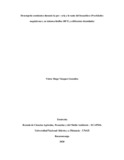Please use this identifier to cite or link to this item:
https://repository.unad.edu.co/handle/10596/36872Full metadata record
| DC Field | Value | Language |
|---|---|---|
| dc.contributor.advisor | Gélvez Higuera, Jorge Edwin | - |
| dc.coverage.spatial | cead_-_bucaramanga | spa |
| dc.creator | Vásquez González, Víctor Hugo | - |
| dc.date.accessioned | 2020-10-20T15:10:46Z | - |
| dc.date.available | 2020-10-20T15:10:46Z | - |
| dc.date.created | 2020-10-19 | - |
| dc.identifier.uri | https://repository.unad.edu.co/handle/10596/36872 | - |
| dc.description | NA | spa |
| dc.description.abstract | Evaluar el desempeño zootécnico durante la pre - cría y levante del bocachico (Prochilodus magdalenae), en sistema biofloc (BFT), a diferentes densidades así: T1 - 2 peces /m3, T2 - 6 peces /m3, T3 - 10 peces /m3 y T4 - 14 peces /m3 Se evaluó: el desempeño productivo (longitud y peso); la sobrevivencia y la composición del floc y del agua de cultivo empleada Los resultados permiten establecer que el bocachico cultivado en sistema BFT, en las condiciones medioambientales y de calidad de agua de la ciénaga San Silvestre en Barrancabermeja (Santander - Colombia), presentó el mejor desempeño en aumento de peso, a una densidad de 2 p/m3 (T1), con una diferencia significativa respecto de los demás tratamientos (T2 - 6 p/m3, T3 - 10 p/m3 y T4 - 14 p/m3). En cuanto a la ganancia en peso de los ejemplares sembrados a una densidad de 2 p/m3, fue de 34,4 g en un período de 80 días, lo que arroja una tasa de crecimiento de 0,43 g/día. De la misma manera, los resultados obtenidos respecto a longitud total (Lt) y ganancia en longitud muestran al T1 - 2 p/m3, como el tratamiento que presentó el mejor desempeño sobre los demás tratamientos. Respecto a la sobrevivencia, no se observó diferencia significativa entre tratamientos (Vp=0,97>0,05). El T4 - 14 p/m3 presentó la supervivencia más alta con un valor de 68,19±19,55a El análisis bromatológico realizado a los flóculos de los cuatro tratamientos presentó valores para proteína entre 27,9% a 36,7% y para extracto etéreo entre 1,1% y 2,2%. | spa |
| dc.format | spa | |
| dc.title | Desempeño zootécnico durante la pre - cría y levante del bocachico (Prochilodus magdalenae), en sistema biofloc (BFT), a diferentes densidades | spa |
| dc.type | Proyecto aplicado | spa |
| dc.subject.keywords | Bocachico: Prochilodus magdalenae | spa |
| dc.subject.keywords | Cria de peces | spa |
| dc.description.abstractenglish | Evaluate the zootechnical performance during pre - rearing and raising of the bocachico (Prochilodus magdalenae), in a biofloc system (BFT), at different densities as follows: T1 - 2 fish / m3, T2 - 6 fish / m3, T3 - 10 fish / m3 and T4 - 14 fish / m3 It was evaluated: the productive performance (length and weight); the survival and composition of the floc and the culture water used The results allow to establish that the bocachico grown in the BFT system, in the environmental conditions and water quality of the San Silvestre swamp in Barrancabermeja (Santander - Colombia), presented the best performance in weight gain, at a density of 2 p / m3 (T1), with a significant difference with respect to the other treatments (T2 - 6 p / m3, T3 - 10 p / m3 and T4 - 14 p / m3). Regarding the weight gain of the specimens sown at a density of 2 p / m3, it was 34.4 g in a period of 80 days, which gives a growth rate of 0.43 g / day. In the same way, the results obtained regarding total length (Lt) and gain in length show T1 - 2 p / m3, as the treatment that presented the best performance over the other treatments. Regarding survival, no significant difference was observed between treatments (Vp = 0.97> 0.05). The T4 - 14 p / m3 presented the highest survival with a value of 68.19 ± 19.55a The bromatological analysis performed on the flocs of the four treatments presented values for protein between 27.9% to 36.7% and for ether extract between 1.1% and 2.2%. | spa |
| dc.subject.category | Zootecnia | spa |
| Appears in Collections: | Zootecnia | |
Files in This Item:
| File | Description | Size | Format | |
|---|---|---|---|---|
| vhvasquezg.pdf | 1.04 MB | Adobe PDF |  View/Open |
Items in DSpace are protected by copyright, with all rights reserved, unless otherwise indicated.
